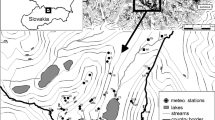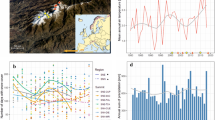Abstract
Alpine vegetation is considered to be particularly sensitive to climate changes. Here we document changes in species richness, distribution and composition over the past 50 years by resurveying vegetation in Rondane, a well-studied alpine area in central Norway. We estimated changes in species occurrences, species richness and species’ realized optima to study relationships between vegetational and environmental change. We used a weighted average approach with elevation and indicator values for light, temperature, pH, moisture, nutrients and tolerance to snow-cover duration. Permutation tests, allowing for unequal sampling in the original survey and the resurvey, indicated whether vegetation changes were statistically significant. We found no significant change in the average number of species per plot since 1950. Of 21 species analysed for changes in frequency and realized optimum, ten showed statistically significant changes in frequency (six decreased, four increased), and six exhibited statistically significant changes in their optimum along the soil-pH gradient. Statistically significant optimum changes were found along the nutrient and light gradients (three species) and the elevation and snow-cover gradients (two species). No statistically significant changes were found along the temperature or moisture gradients. In comparison with other studies, our results suggest that recent climate changes have had a relatively low impact on alpine vegetation in the Rondane mountains. This is indicated by our species optimum analysis, which revealed few changes along gradients that can be directly linked to the climate (temperature and soil moisture) whereas most detected changes appear to be responses to factors related to soil pH. The relative constancy of species’ optima and hence species composition may be explained most parsimoniously by the species pool in the Rondane area, which consists largely of common and widespread species with wide ecological amplitudes and hence broad tolerances to environmental change.


Similar content being viewed by others
References
Aerts R, Cornelissen J, Dorrepaal E, (2006) Plant performance in a warmer world: general responses of plants from cold, northern biomes and the importance of winter and spring events. Plant Ecol 182:65–77
Aerts R, Cornelissen J, Dorrepaal E, Van Logtestijn R, Callaghan T (2004) Effects of experimentally imposed climate scenarios on flowering phenology and flower production of subarctic bog species. Glob Change Biol 10:1599–1609
Araujo MB, Rahbek C (2006) How does climate change affect biodiversity? Science 313:1396–1397
Bray J, Curtis J (1957) An ordination of the upland forest communities of southern Wisconsin. Ecol Mon 27:325–349
Chytrý M, Tichý L, Hennekens, SM, Schaminée JHJ (2014) Assessing vegetation change using vegetation-plot databases: a risky business. Appl Veg Sci 17:34–41
Coudun C, Gégout JC (2007) Quantitative prediction of the distribution and abundance of Vaccinium myrtillus with climatic and edaphic factors. J Veg Sci 18:517–524
Currall JEP (1987) A transformation of the Domin scale. Vegetatio 72:81–87
Dahl E (1956) Rondane. Mountain vegetation in south Norway and its relation to the environment. Skr. norske videnskaps-akademi, I Mat-Nat 3, Oslo, 374 pp
Dahl E (1988) Acidification of soils in the Rondane Mountains, South Norway, due to acid precipitation. Økoforsk rapport 1988(1), 53 pp
Dawson TP, Jackson ST, House JI, Prentice IC, Mace GM (2011) Beyond predictions: biodiversity conservation in a changing climate. Science 332:53–58
Edgington ES (1995) Randomization Tests. Marcel Dekker, New York, NY, US.
Ellenberg H, Weber HE, Düll R, Wirth V, Werner W, Paulißen D (1991) Zeigerwerte von Pflanzen in Mitteleuropa. Ed. 2. Scripta Geobot 18:1–248
Engler R, Randin, CF, Thuiller W, Dullinger S, Zimmermann NE, Araujo MB et al (2011) 21st century climate change threatens mountain flora unequally across Europe. Glob Change Biol 17:2330–2341
Engler R, Randin CF, Vittoz P, Czaka T, Beniston M, Zimmermann NE et al (2009) Predicting future distributions of mountain plants under climate change: does dispersal capacity matter? Ecography 32:34–45
Felde VA, Kapfer J, Grytnes J-A (2012) Upward shift in elevational plant species ranges in Sikkilsdalen, central Norway. Ecography 35:922–932
Grabherr G, Gottfried M, Pauli H (1994) Climate effects on mountain plants. Nature 369:448
Grime JP, Hodgson, JG, Hunt R (1988) Comparative plant ecology: a functional approach to common British species. Unwin Hyman, London
Grytnes J-A, Kapfer J, Jurasinski G, Birks HH, Henriksen H, Klanderud K et al (2014) Identifying driving factors behind observed elevational range-shifts on European mountains. Global Ecol Biogeogr 23:876–884
Hanssen-Bauer I (2005) Regional temperature and precipitation series for Norway: Analyses of time-series updated to 2004. www.met.no report (15, 2005 – climate)
Kapfer J, Grytnes J-A, Gunnarsson U, Birks HJB (2011) Fine-scale changes in vegetation composition in a boreal mire over 50 years. J Ecol 99:1179–1189
Kapfer J, Birks HJB, Felde VA, Klanderud K, Martinessen T, Ross LC et al (2013) Long-term vegetation stability in northern Europe as assessed by changes in species co-occurrences. Pl Ecol Div 6:289–302
Klanderud K, Birks HJB (2003) Recent increases in species richness and shifts in altitudinal distributions of Norwegian mountain plants. Holocene 13:1–6
Lenoir J, Gegout JC, Marquet PA, de Ruffray P, Brisse H (2008) A significant upward shift in plant species optimum elevation during the 20th century. Science 320:1768–1771
Lid J, Lid DT (1994) Norsk flora. 6rd ed. Det norske samlag, Oslo
Manly BFJ (2007) Randomization, bootstrap and Monte Carlo methods in biology. Chapman & Hall/CRC Press, London, UK
Odland A, Munkejord HK (2008) Plants as indicators of snow layer duration in southern Norwegian mountains. Ecol Indic 8:57–68
Olofsson J (2006) Short- and long-term effects of changes in reindeer grazing pressure on tundra heath vegetation. J Ecol 94:431–440
Pellissier L, Bråthen KA, Pottier J, Randin CF, Vittoz P, Dubuis A et al (2010) Species distribution models reveal apparent competitive and facilitative effects of a dominant species on the distribution of tundra plants. Ecography 33:1004–1014
Resvoll-Holmsen H (1912) Om vegetasjonen ved Tessevand i Lom. I kommission hos Dybwad, Kristiania
Resvoll-Holmsen H (1914) Statistiske vegetationsundersøgelser fra Foldalsfjeldene. I kommission hos Dybwad, Kristiania
Root TL, Price JT, Hall KR, Schneider SH, Rosenzweig C, Pounds JA (2003) Fingerprints of global warming on wild animals and plants. Nature 421:57–60
Ross LC, Woodin SJ, Hester A, Thompson DBA, Birks HJB (2010) How important is plot relocation accuracy when interpreting re-visitation studies of vegetation change? Pl Ecol Div 3:1–8
Saksgård R, Schartau AK (2004) Kjemisk overvåkning av norske vassdrag – Elveserien 2004. NINA Rapport. Trondheim. 72:71–59
Stutzer A (1999) Podzolisation as a soil forming process in the alpine belt of Rondane, Norway. Geoderma 91:237–248
Walther GR (2010) Community and ecosystem responses to recent climate change. Philos T Roy Soc B 365:2019–2024
Acknowledgements
We thank Radim Hédl and Arvid Odland for comments on an earlier draft. The field work was funded by the Faculty of Mathematics and Natural Sciences, University of Bergen. The research has received funding from the Polish-Norwegian Research Programme operated by the National Centre for Research and Development under the Norwegian Financial Mechanism 2009–2014 in the frame of Project Contract No. Pol-Nor/196829/87/2013. We are grateful to Petr Šmilauer and three reviewers for their helpful and constructive comments and suggestions.
Author information
Authors and Affiliations
Corresponding author
Electronic supplementary material
Below is the link to the electronic supplementary material.
ESM 1
(DOCX 83 kb)
Rights and permissions
About this article
Cite this article
Schei, F.H., Kapfer, J., Birks, H.J.B. et al. Stability of alpine vegetation over 50 years in central Norway. Folia Geobot 50, 39–48 (2015). https://doi.org/10.1007/s12224-015-9209-9
Received:
Accepted:
Published:
Issue Date:
DOI: https://doi.org/10.1007/s12224-015-9209-9




